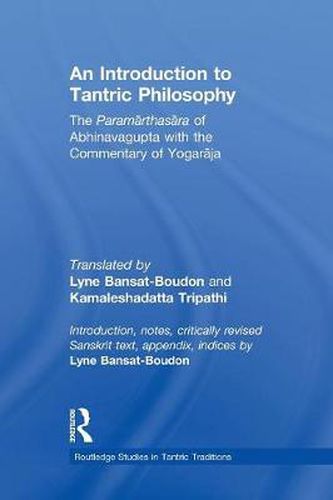Readings Newsletter
Become a Readings Member to make your shopping experience even easier.
Sign in or sign up for free!
You’re not far away from qualifying for FREE standard shipping within Australia
You’ve qualified for FREE standard shipping within Australia
The cart is loading…






The Paramarthasara, or ‘Essence of Ultimate Reality’, is a work of the Kashmirian polymath Abhinavagupta (tenth-eleventh centuries). It is a brief treatise in which the author outlines the doctrine of which he is a notable exponent, namely nondualistic Saivism, which he designates in his works as the Trika, or ‘Triad’ of three principles: Siva, Sakti and the embodied soul (nara).
The main interest of the Paramarthasara is not only that it serves as an introduction to the established doctrine of a tradition, but also advances the notion of jiv anmukti, ‘liberation in this life’, as its core theme. Further, it does not confine itself to an exposition of the doctrine as such but at times hints at a second sense lying beneath the evident sense, namely esoteric techniques and practices that are at the heart of the philosophical discourse. Its commentator, Yogaraja (eleventh century), excels in detecting and clarifying those various levels of meaning. An Introduction to Tantric Philosophy presents, along with a critically revised Sanskrit text, the first annotated English translation of both Abhinavagupta’s Paramarthasara and Yogaraja’s commentary.
This book will be of interest to Indologists, as well as to specialists and students of Religion, Tantric studies and Philosophy.
$9.00 standard shipping within Australia
FREE standard shipping within Australia for orders over $100.00
Express & International shipping calculated at checkout
The Paramarthasara, or ‘Essence of Ultimate Reality’, is a work of the Kashmirian polymath Abhinavagupta (tenth-eleventh centuries). It is a brief treatise in which the author outlines the doctrine of which he is a notable exponent, namely nondualistic Saivism, which he designates in his works as the Trika, or ‘Triad’ of three principles: Siva, Sakti and the embodied soul (nara).
The main interest of the Paramarthasara is not only that it serves as an introduction to the established doctrine of a tradition, but also advances the notion of jiv anmukti, ‘liberation in this life’, as its core theme. Further, it does not confine itself to an exposition of the doctrine as such but at times hints at a second sense lying beneath the evident sense, namely esoteric techniques and practices that are at the heart of the philosophical discourse. Its commentator, Yogaraja (eleventh century), excels in detecting and clarifying those various levels of meaning. An Introduction to Tantric Philosophy presents, along with a critically revised Sanskrit text, the first annotated English translation of both Abhinavagupta’s Paramarthasara and Yogaraja’s commentary.
This book will be of interest to Indologists, as well as to specialists and students of Religion, Tantric studies and Philosophy.